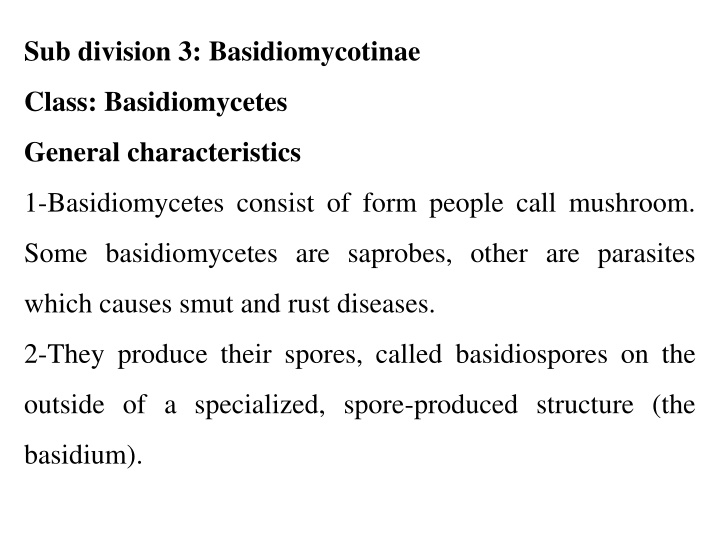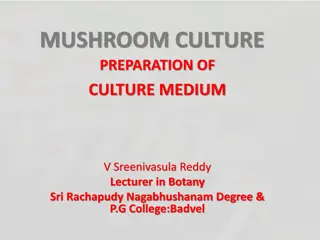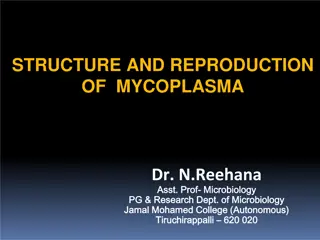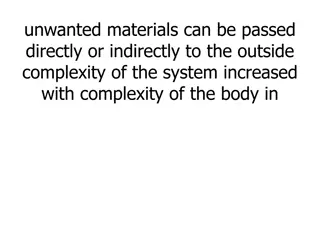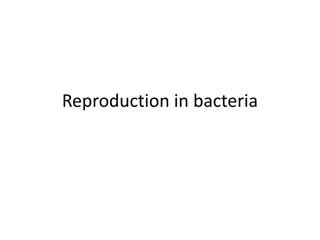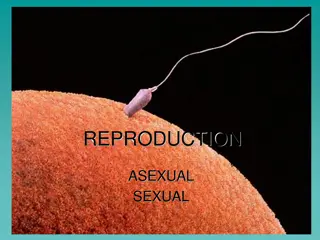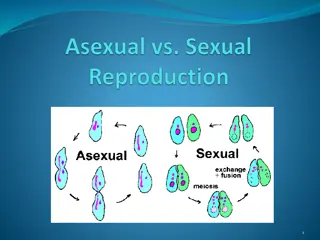Basidiomycetes: Mushroom Characteristics and Reproduction
Basidiomycetes, commonly known as mushrooms, exhibit diverse characteristics like saprophytic and parasitic behaviors. Their life cycle involves primary and secondary mycelium stages, each contributing to reproduction through spermatization or somatogamy. The presence of clamp connections aids in nuclear division. Asexual reproduction occurs through budding or fragmentation. Complex basidiomycetes develop fruiting bodies called basidiocarps, containing basidia and sterile elements like Cystidium in the hymenium layer.
Download Presentation

Please find below an Image/Link to download the presentation.
The content on the website is provided AS IS for your information and personal use only. It may not be sold, licensed, or shared on other websites without obtaining consent from the author.If you encounter any issues during the download, it is possible that the publisher has removed the file from their server.
You are allowed to download the files provided on this website for personal or commercial use, subject to the condition that they are used lawfully. All files are the property of their respective owners.
The content on the website is provided AS IS for your information and personal use only. It may not be sold, licensed, or shared on other websites without obtaining consent from the author.
E N D
Presentation Transcript
Sub division 3: Basidiomycotinae Class: Basidiomycetes General characteristics 1-Basidiomycetes consist of form people call mushroom. Some basidiomycetes are saprobes, other are parasites which causes smut and rust diseases. 2-They produce their spores, called basidiospores on the outside of a specialized, spore-produced structure (the basidium).
3-The mycelium of most basidiomycetes passes through three distinct stages before the fungus completes its life cycle: The primary mycelium (1n):- Usually develops from the germination of a basidiospore. It is septate and uninucleate from the beginning. It gives rise to;-Secondary mycelium: Usually involves an interaction between two compatible mycelia (n+n) (Dikaryon).
4-There are no sexual organs in class basidiomycetes, so the sexual reproduction occurs by spermatization or Somatogamy. 5-Basidiomycetes characterized by presence of clamp connections, that are formed during nuclear division when the binucleate cell is ready to dived, a short-branch arises between the two nuclei (a) and (b) and begins to form a hook. The nuclei now divide. One division becomes oriented obliquely, so that one daughter nucleus (b) forms in the clamp connection and the other (b) forms in the dividing cell.
The second division orients itself along the long axis of the dividing cell, so that one daughter nucleus (a) forms near one end of the cell and the other ( ) approaches the nucleus (b) of the first division near the other end of the cell. In the meantime, the clamp has bent over, and its free end has fused with the cell, so that the clamp forms a bridge through which one of the daughter nuclei (b) passes to other end of the cell and approaches one of the daughter nuclei (a) of the other division. A septum forms to close the clamp at the point of its origin and another septum forms vertically under the bridge to divide the parent cell into two daughter cells with (a) and (b) nuclei in one daughter cell and ( ) and (b ) in the other as shown in the following diagram.
Asexual reproduction It does not important in this class, and it occurs either by budding or fragmentation. The basidiocarps: the more complex basidiomycetes produce their basidia in highly organized fruiting bodies of various types. In a basidiocarp the hymenium is a layer composed of basidia as well as any other sterile elements such as Cystidium.
